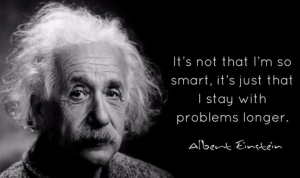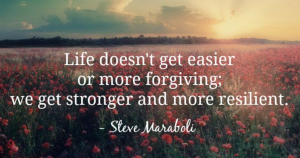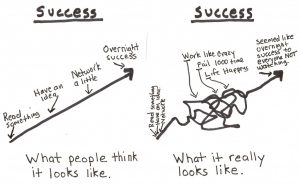Strategy #6: Persevere – “Hold the Course”
The heroic journey for teenagers takes a long time – eight to ten years or so. That means that a key to success is being able to stay on the path and stay healthy. That means persevering.
- Becoming more and more resilient
- Avoiding the energy traps and finding the sources of energy
- Developing the awareness to stay on track and learn from the experience
These are also keys to life as an adult, but they are critical for the teenage years because of the number of challenges and changes and just how long the journey is.
Presidents of organizations face a similar challenge in finding ways to keep their organizational change on track – persevering. The problem is that people naturally get worn down in changing because it takes a lot of energy. They can lose sight of the vision. They can lose confidence when they hit setbacks and surprises. So presidents have to find ways to stay on track, maintain or renew energy and confidence, and develop people’s resilience.

Sometimes it Just Comes Down to Persevering
Perseverance: Refusing to quit, to give up in the face of setbacks, disappointments or losses
It is refusing to be a victim. There are times when anyone can be hurt, discouraged, depressed, scared or anxious, tired or worn out. You just can’t quit.
The Journey is Like a Rollercoaster
It’s often an emotional rollercoaster and sometimes a physical, intellectual or even spiritual rollercoaster. There will be ups and downs by definition. There will be successes and failures. The key is to enjoy the successes and the ups – and survive or power through the failures and the downs.
You can Build a Foundation for Perseverance
You will find that your ability to persevere will depend heavily on how much success you have had creating your vision and plan as well as how well you have done developing a web of support. That will help you deal with the challenges of mastery (remember “learning to love the plateau”?) as well as recovering from the inevitable setbacks and injuries that everyone encounters in some form of the journey. And, of course, experience helps.
Courage doesn’t always roar. Sometimes courage is the little voice at the end of the day that says…I’ll try again tomorrow.
Mary Anne
Radmacher-Hershey
Resilience – “Bouncing Back”
“Resilience is very different than being numb. Resilience means you experience, you feel, you fail, you hurt. You fall. But, you keep going.” Yasmin Mogahed
Resilience is the Ability to Successfully Adapt to Life
Resilience is dealing with the inevitable stresses, traumas, threats and setbacks. Life comes with relationship problems, family problems, health problems, school and work problems. That’s just the way it works and our resilience helps us “bounce back” – increasingly strong, wise and flexible.
You’re Not Born With Resilience
Resilience is not a characteristic that people are simply born with – or without. The good news is that research has shown that resilience is ordinary, not extraordinary. It involves thoughts and behaviors that can be learned and developed and it grows through experience. Some people are more resilient than others, but resilience is a surprisingly common characteristic of people of all ages – although sometimes you have to look for it when you don’t feel particularly resilient.
Being Resilient Does Not Mean You Don’t Experience Distress
Emotions like anger, anxiety, fear, uncertainty, doubt, depression, confusion, or lack of hope are natural in tough or traumatic situations. In fact, it’s not particularly healthy to not feel some of those emotions. The key is to experience and accept them and then manage them. That sets the stage for bouncing back.
Trauma and/or Opportunity
Different people will have different reactions to the same potentially traumatic event. Those reactions can range from being traumatized to
seeing a tough situation that provides the opportunity to grow and develop – to get stronger, smarter about life, more resilient, more mature. Often, after initially being badly hurt or traumatized by a situation, a person can flip over into going after the potential opportunities for growth. Sometimes that takes a while to make the shift, but you can make the shift.

Developing Resilience
“Our greatest glory is not in never falling but in rising every time we fall.” Confucius
There is No Magic Formula for Developing Resilience
But there are things that you can do to help you build resilience in almost any setting. These actions will look different for different people, but they will work for almost anyone. The key is using as many of these actions as possible and not relying one any one or two.
It Takes Time and Effort and Experience
Resilience doesn’t develop all at once. You may not feel very resilient, but you can develop it.
Use Your Support Network
Support networks have been talked about in most sections of this site – for a good reason. They matter – a lot. Whether face-to-face or digital, support networks can make a big difference in your resilience – your ability to bounce back from difficult or traumatic events. Remember – support networks can include individuals, groups or organizations that you are connected to.
If you don’t have a good support network, all is not lost. It just makes the other strategies for developing resilience more important.
Keep Things in Perspective
You can’t change the fact that highly stressful events happen, but you can change how you interpret and respond to these events.
- The area of difficulty or trauma is not the only area of your life, so don’t let it dominate (at least not for long).
- “Now” is not forever, so don’t let the difficulty or trauma color how you see your future.\
- Avoid blowing the event out of proportion. The experience might initially seem huge, but then appear smaller when you have a chance to step back and look at it.

Take Decisive Actions
Act on adverse situations as much as you can. Take decisive actions, even if they are small actions, rather than withdrawing or feeling paralyzed. Small actions matter, particularly when they keep coming.
Some of the decisive actions will relate to the other strategies in this section, for example calling on people or groups in your support network, taking care of yourself or focusing on engaging in activities you enjoy.
Manage Yourself
Look for opportunities for self-discovery. People often learn something about themselves and may find that they have grown in significant ways as a result of their experience with traumatic or difficult situations. Sometimes those opportunities are obvious, but sometimes you have to look for them.
Remember what you’ve done in the past. Think back on experiences you’ve had where you had to bounce back from a loss you suffered or when you had to solve significant problems. You will develop resilience over time, but don’t ignore what you have already developed.
Take care of yourself. Engage in activities that you enjoy and find rewarding or stress reducing. This varies widely for people and can include activities like exercise, going to movies, surfing the internet for interesting sites, writing in a journal, going for walks, hunting, creating art, etc. It often doesn’t take much to make a big difference.
"My scars remind me that I did indeed survive my deepest wounds. That in itself is an accomplishment. And they bring to mind something else, too. They remind me that the damage life has inflicted on me has, in many places, left me stronger and more resilient. What hurt me in the past has actually made me better equipped to face the present.”
Steve
Goodier
The Energy Traps: “Challenges to the Heart”

Living Takes Energy – the Teen Journey Takes Lots of Energy
The first section addresses how energy can be lost or quickly burned up. The next section looks at sources of energy – of which there are a surprising number.
One word of Caution
The energy traps that follow are natural and everyone must deal with them. They are just part of the landscape on the journey. Their existence does not mean that something is wrong or that mistakes have been made or you are off the path.
Reviewing the list is particularly helpful when your energy starts to diminish. Sometimes just identifying a source of energy drain can take the power away from it. You can also talk with others and help each other deal with these energy traps
The fact that there are an impressive number of energy traps may be daunting, but that’s the way it works on the journey. Everyone is dealing with these demons. The key is to:
- Know they are there
- Understand that they are natural and not an indication that you are failing or inadequate
- Deal with them directly
- Remember that heroes don’t go alone, so talk with others about how to deal with them

Common Energy Traps Encountered on the Journey
Traps Focused on You
|
Traps Focused Beyond You
|
Sources of Life Energy for the Journey
The 70/30 Principle
One of the differences between these sources of energy and the preceding energy traps is that people on a heroic journey usually have more influence over the sources of energy than they do over the energy traps.
The 70/30 Principle
That is not true in every instance, but it does reinforce the 70/30 principle, which argues that it is best to spend 70% of your attention and effort taking advantage of the sources of energy and 30% dealing with the energy traps.
Being the Author
Taking advantage of these sources of energy is another direct challenge to “be the author”. It means not allowing yourself to be the victim of the inevitable traps. This is a big list of possible sources of energy, so stay aware of just how many opportunities there are for you to take care of yourself. Some of these sources of energy are simple and some are more complex. Simple can still be powerful. The key is to draw energy from a bunch of these sources.

Possible Sources of Life Energy
|
|
Staying on the Path – Three Questions

How will you stay on your path? The best way to do this is to do frequent and informal check-ins – and do them with others as much as possible. A good way to do a review is in three parts (celebrate, learn and determine next actions).
This three-part check-in also creates energy. It’s focused on what you have done – not what you have not done. It celebrates small wins and draws learning from the experiences you have had whether successful or not so successful. It also focuses on what to do next.
First ask, “What do I have to celebrate right now?”
These can be final goal achievements or steps on the way (even small steps). Success is usually the result of lots of small wins, so it’s important to notice and celebrate the small wins. They may be small celebrations for small wins, but don’t ignore them.
“Success is the sum of small efforts, repeated day in and day out.” Robert Collier
Second, ask, “What have I learned?”
You might have learned something about yourself, about what’s required to achieve a goal, about others, about relationships, about how the world works, etc.
“If you are not willing to learn, no one can help you. If you are
Determined to learn, no one can stop you.” Anonymous
Third ask, “What do I want to keep doing, start doing or stop doing?”
This gives you a lot of power because you can keep identifying the most effective actions.
“Perseverance is not a long race; it is many short races one after the other.” Walter Elliot
The key is to pay attention to how you are doing, but keep it informal – and leave the judgement out of it. Learn from the mistakes and use the learning, but don’t let it diminish you. It’s part of the journey.
You will be surprised at how much of a difference these informal check-ins can make in staying on your path.
A Life-Long Skill
One of the benefits to paying attention to renewing energy and staying on the path as a teenager is that it naturally builds your ability to deal with change and that will be important throughout life. By paying attention you get more savvy, you become more resilient, and your confidence grows.
The teenage journey is a long one and your life energy will naturally go up and down along the path. If you get used to focusing some on the energy traps and how to avoid or manage them – but mostly on the sources of energy – you will not only be more successful on the teenage journey, you will develop good practices and habits for life as an adult.

"You never know what's around the corner. It could be everything. Or it could be nothing. You keep putting one foot in front of the other, and then one day you look back and you've climbed a mountain."
Tom
Hiddleston